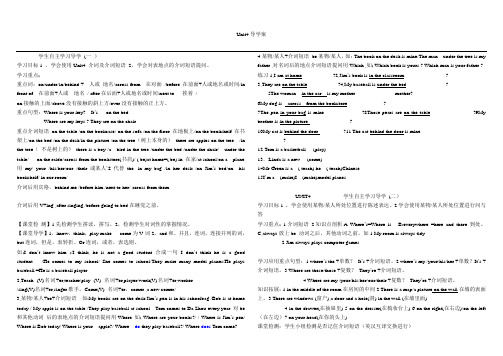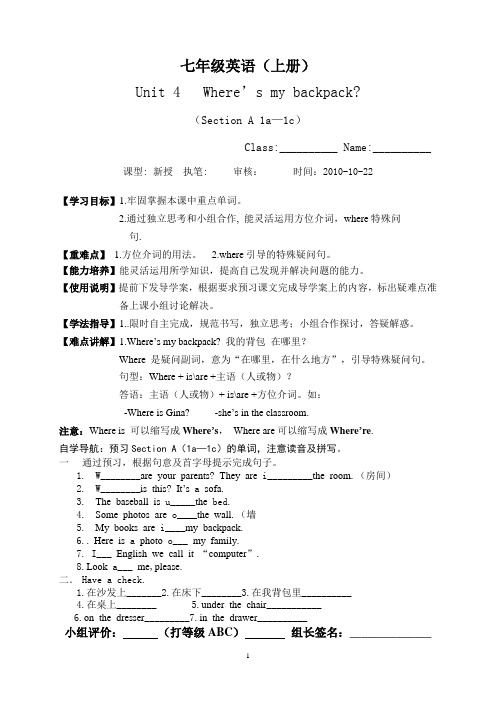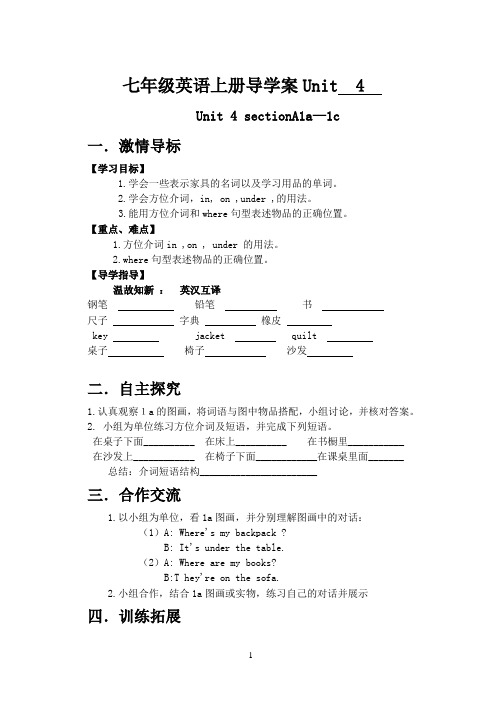七上Unit 4导学案定稿
- 格式:doc
- 大小:274.50 KB
- 文档页数:10


学生自主学习导学(一)学习目标1 ,学会使用Unit4 介词及介词短语2,学会对表地点的介词短语提问。
学习重点;重点词:on/under/in/behind + 人或地名/across from 在对面/before 在前面+人或地名或时间/in front of 在前面+人或地名/ after在后面+人或地名或时间/next to 挨着/on接触的上面/above没有接触的斜上方/over没有接触的正上方。
重点句型:Where is your key? It’s on the bedWhere are my keys ? They are on the chair .重点介词短语on the table /on the bookcase/ on the sofa /on the floor 在地板上/on the bookshelf 在书架上/on the bed /on the desk/in the picture /on the tree(树上本身的)there are apples on the tree /in the tree(不是树上的)there is a boy /a bird in the tree /under the bed /under the chair/ under the table/ on the raido/across from the bookstore(书店)/ ( be)at home=( be) in 在家/at school/on a plane 用my/ your /his/her/our /their或某人’S 代替the .in my bag /in her desk /on Jim’s bed/on his bookshelf/ in our room/介词后用宾格,behind me /before him /next to her/ across from them介词后用V+ing ,after singing,/before going to bed.在睡觉之前。

七年级英语导学案主备审核课型语法课时间序号U4.2课题Unit 4 Grammar Focus学习目标5.在谈论最喜爱的科目的环境中正确理解和运用学科类名词和描述性形容词;6.通过观察讨论等课堂活动,总结连词的用法;7.正确使用学科类名词,描述性形容词和连词,与同学谈论最喜爱的科目及原因。
学习重点4.进一步掌握学科类名词及描述性形容词;5.连词and,but和because的使用规则。
课堂规划1.复习所学2.自主预习本课新词3.小组研讨4.新知学习5.达标检测6.课堂小结学习过程导学设计问题记录材料呈现一、自主复习(巩固所学,英译汉)1.地理学______________2.历史__________3.乏味的,令人生厌的___________________4.了解过去________________________5.有用的学科________________________5.最喜欢的科目____________________6我最喜欢的科目是英语。
_____________________________7.你为什么喜欢英语?_____________________________8.学习数学对我来说是困难的。
______________________二、新知认知(自我突破,评价自我)1.give a reason2.give another idea3. 擅长英语4. 画画5. 使课堂有趣6.remember all the information7.make everyone feel special8.有一辆自行车_________________________9.学习用电脑很有趣____________________10.使课堂有趣____________________11.我今天有美术和地理课。
__________________________________12.他不喜欢数学,因为它很难。

Unit 4 Where is my schoolbag?Period 1Name: _______ Class: ________ Group: _______【学习目标】1、通过早读背会unit4单词,并熟读section A 中1a,2c和section B 中1d的句子.2、通过听力练习,掌握如下句型:Where is my schoolbag? It’s under the table.Where are your English books ? They’re on the sofa.Is my puter game on the table ? No, it isn’t. It’s in the bookcase.Are they in the bookcase ? No, they aren’t. They’re on the chair.3、通过本节课学习及练习,掌握一定的听力技巧并熟练运用。
【重难点】教学重点:Where is my schoolbag?It’s under the table.教学难点:熟练掌握听力技巧并会用。
【导学流程】一、基础感知Where's the map? It's in your grandparents' room.Where are my books?They're on the sofa.Where's his pencil box?It's in his schoolbag.Where's your ruler?It's under the chair.Where are their keys?They're on the table.二、独立深思快速浏览P19中1b;P20中2a、2b;P22中1c、1d。
Task1 观察1a图片并完成题目要求。
Task2 听录音完成P19 1b。

七年级英语(上册)Unit 4 Where’s my backpack?(Section A 1a—1c)Class:__________ Name:__________ 课型: 新授执笔: 审核:时间:2010-10-22【学习目标】1.牢固掌握本课中重点单词。
2.通过独立思考和小组合作, 能灵活运用方位介词,where特殊问句.【重难点】 1.方位介词的用法。
2.where引导的特殊疑问句。
【能力培养】能灵活运用所学知识,提高自己发现并解决问题的能力。
【使用说明】提前下发导学案,根据要求预习课文完成导学案上的内容,标出疑难点准备上课小组讨论解决。
【学法指导】1..限时自主完成,规范书写,独立思考;小组合作探讨,答疑解惑。
【难点讲解】1.Where’s my backpack? 我的背包在哪里?Where 是疑问副词,意为“在哪里,在什么地方”,引导特殊疑问句。
句型:Where + is\are +主语(人或物)?答语:主语(人或物)+ is\are +方位介词。
如:-Where is Gina? -she’s in the classroom.注意:Where is 可以缩写成Where’s,Where are可以缩写成Where’re.自学导航:预习Section A(1a—1c)的单词,注意读音及拼写。
一通过预习,根据句意及首字母提示完成句子。
1.W________are your parents? They are i_________the room.(房间)2.W________is this? It’s a sofa.3.The baseball is u_____the bed.4.Some photos are o____the wall.(墙5.My books are i____my backpack.6.. Here is a photo o___ my family.7. I___ English we call it“computer”.8.Look a___ me,please.二.Have a check.1.在沙发上_______2.在床下________3.在我背包里__________4.在桌上________5.under the chair___________6.on the dresser_________7.in the drawer__________小组评价:(打等级ABC)组长签名:______________一、选择填空。

七年级英语上册导学案Unit 4Unit 4 sectionA1a—1c 一.激情导标【学习目标】1.学会一些表示家具的名词以及学习用品的单词。
2.学会方位介词,in, on ,under ,的用法。
3.能用方位介词和where句型表述物品的正确位置。
【重点、难点】1.方位介词in ,on , under 的用法。
2.where句型表述物品的正确位置。
【导学指导】温故知新:英汉互译钢笔铅笔书尺子字典橡皮key jacket quilt桌子椅子沙发二.自主探究1.认真观察1a的图画,将词语与图中物品搭配,小组讨论,并核对答案。
2. 小组为单位练习方位介词及短语,并完成下列短语。
在桌子下面__________在床上__________ 在书橱里___________ 在沙发上____________ 在椅子下面____________在课桌里面_______ 总结:介词短语结构_______________________三.合作交流1.以小组为单位,看1a图画,并分别理解图画中的对话:(1)A: Where's my backpack ?B: It's under the table.(2)A: Where are my books?B:T hey're on the sofa.2.小组合作,结合1a图画或实物,练习自己的对话并展示四.训练拓展一、根据汉语意思连词成句。
1.我的尺子在课桌上。
on, desk, the, my, is, ruler_______________________________ 。
2.那只棒球在双肩背包里。
Backpack, the, in the, baseball, is_________________________________________ 。
3.那只钢笔在书的下面。
under, pen, the, book, the is ________________________________ 。
七年级上册Unit 4英语导学案Unit 4 Where 's my schoolbag?1.检查预习情况。
单词检查——第一:先全班齐读,再由个别自主完成全员参与学生读,其他学生纠错;第二,默写单词:每个组一名学生在黑板上写,然后一起核对。
2.讨论解决预习中短语、句子及其他存在的问题,教师释疑。
组内同学互检,订正。
3听力:听录音完成1b.然后跟读听力材料后自读课文一遍,再在小组内朗读课文,最后抽小组成员比赛朗读。
4、运用方位介词in, on, under ,behind。
(1)口头操练where's …?/where are …?等句型A:Where 's my schoolbag? B: It's under thetableA: Where are my books? B: They're on the sofa.(2)小组为单位,两人合作,结合1a图画或实物,练习自己的对话并展示。
四、展示提炼拓展延伸完成句子1.我的双肩包在哪里?在桌子下面。
________ _____ my schoolbag? It's ______ ____________.2.我的书(books)在哪里?在沙发上。
_______ _______ my books? They are ______ ____________.3.我的尺子在课桌上。
on, desk, the, my, is, ruler_______________________________.4.那只棒球在双肩背包里。
Schoolbag, the, in the,baseball, is_________________________________________.五、达标测试效果反馈(一)选择1. Where is my book? It's under _____ table .A. my theB. the myC. my2. Where ____ his keys? A. is B. are C.am D. be3. ____ your bag ? At school.A. What'sB. WhatC. Where'sD. WhereUnit 4 Where 's my schoolbag?Unit 4 Where 's my schoolbag?三、自主学习合作探究学生自学“Grammar Focus”小组讨论Where is the map? Where are my books?及其回答。
人教版七年级英语上册导学案班级:组名___________ 姓名:学习内容:Unit 4 Don't eat in class.Section A (1a-2d)学习目标:1) 能掌握以下单词:rules, arrive, late, hall, dinning hall, listen, listen to, fight, sorry2) 能掌握以下句型:①Don't eat in class. ②You must be on time. ③Eat in the dining hall.2. 学会用英语表达一些标志的含义。
3. 熟练使用目标语言谈论对某些规章制度(校规、家规等)的看法I.Self--study—学有准备,轻松在课堂(一)重点词汇:上课迟到______________ 准时______________ 听音乐______________ 戴帽子______________ 许多规则______________ 必须____________ 穿校服_________(二)找出以下重点句:①—Don’t run in the hallways.②—Be quiet in the library.③—Can we bring music players to school?(三)听力:听录音,完成1b、2a、2b,并且核对答案。
(四)阅读2d,找出重点内容,用红笔做记号。
1. arrive 到达= get (to)1) arrive 后面可以不跟到达的地点。
Don’t arrive late for school. 不要上学迟到。
2) arrive后面也可以跟到达的地点。
但后面必须要跟介词in (大地方)或at(小地方)。
They arrived in Beijing at six.他们六点钟到的北京。
We usually arrive at the village in the morning.我们通常在早上到那个小村庄。
课题:Unit 4 Section A (1a-2c)课型:新课执笔:集备:年_ 月_ _日教学:日星期班第小组学生姓名学习目标:1.掌握本节课的词汇及句型。
2.掌握表示位置的介词的用法。
3.会谈论物品的位置。
重难点:重点:词汇:where, where’s = where is, where’re = where are, table,bed, bookcase, sofa, on, under, come, come on, desk, in, schoolbagon the sofa, under your bed, in your schoolbag ,under the table 句型:(1) --- Where’s the schoolbag?--- It’s under the table .(2) --- Where’re my books ?--- They’re on the sofa .(3)---Are the keys on the sofa ?---No, they aren’t. They’re on the table.难点:正确区分on, in, under 的用法。
学习器材:多媒体展台自主学习指导:1.熟读重难点词汇、句型,标上汉译,并背会。
2.读1a右图中的对话,完成1a 。
3. 再读1a右图中的对话和1c对话,并自编3组对话。
(分别用上单数和复数,并分别用上on, in, under )(1)A:B:(2)A:B:(3) A:B:拓展与探究:1.完成听力练习1b,2a,2b。
2.根据听力对话练习和1a,1c对话及词汇,自编一组询问物品位置的对话:A:B:A:B:A:B:3.写出on,in ,under 三个方位介词的区别,并列举几个短语:___________________________________________________________ _________4.总结询问物品位置的句型有:单数:问句:_______________________答语:_________________ 复数:问句:_______________________答语:_________________ 课堂小结:总结一下本节课的知识点:课堂评价:评价内容自学情况自学检测课堂反馈课堂参与等级评价人:课题:Unit 4 Section A (1a-2c)课型:新课执笔:集备:年_ 月_ _日教学:日星期班第小组学生姓名自主学习检测:英汉互译1. 在沙发上________________2.在你的书包里_______________3. 电脑游戏__________________4.在你的床底下_______________5.在桌子上___________________6.在书包里_________________等级:_________ 课堂反馈检测:完成下列练习:(1)--- 我的书包在哪里?--- 在桌子下面。
Unit4 Whereas my schoolbag?编号070401Section A (la-2d)制作:审核:英语组制作时间:得分:____________________新课标要求:使学生学会基本句型“Where,s...?It,s...v及“Wherele…? They're. J 学会运用方位介词u on/in/under/behind/next to”表达物品的位置。
一.【学习目标】1.能准确读出P98的单词,并准确说出单词的中文意思。
2.学会运用表示方位的介词谈论物品,以及使用where来询问人或物的位置。
Where9s the schoolbag? It9s under the table •Are the keys on the sofa? No, they aren^t. They9re on the table.【学习重点】1.方位介词a on/in/under/behind/nextto w等的用法;2.where引导的特殊疑问句和一般疑问句:Is/Are the...in/on/under the...?的肯定、否定回答;【学习难点】1 •学会正确描述物品所在的位置;2.学会询问自己或他人物品的具体位置。
二.【学习过程】【预习导航】(-)汉译英1 •在椅子上_______________________2 •在沙发下面________________________3 .在书桌里________________________4 •在头上____________________________5 •在书橱里_______________________6 •在床上____________________________(二)自主学习Taskl: Preview the new words(P98 where -under )目标:会读,知道单词的意思.要求:1.在单词音标上划出音节2 •尝试拼读出单词3.识记1分钟后,能快速说出其中文意思三.【课堂探究】Task2:完成“ 目标:会英汉互译单词,会翻译句型要求:1 .把la中的英语单词译成中文,写在课本上2.将单词与图中物品配对3.标题解读:Where's my schoolbag?译为:____________________4.翻译图片中的对话Task3: Listening P19 lb1.听前:仔细看题目,要求听什么?___________________2.听中:听的重点是什么?____________________3.听后:跟读录音,重复题中重要信息. _________________Task4: Make new conversations P19 lc目标:大声朗读句子,会编新对话要求:1.大声朗读lc对话,并试着口头翻译2.与同伴练习对话3.编新对话A:___________________________________B: __________________________________Task5: Listening 完成2a 和2b1.完成2a.听录音,为物品编号2.完成2b.再听一边录音,找岀2a中的物品并编号Task6: P20 2c目标:就2c图中的物品的位置与同伴问答。
孝南区实验中学七年级英语学科导学案姓名:班级:自我评价:Unit4 Section A(1a---2d)I.学习目标:1.会问、答物品的位置2.理解in on under behind的用法。
3.能说出物品的名称。
The First Period ( Section A 1a---Grammar Focus )II.课堂学习过程:一、交流检查、情感启动,导入新课:1、读单词,让同位听,纠正读音。
2、限时让学生书写:where table bed bookcase sofa chair desk under their under on know bag 检查单词的书写情况。
3、利用大卡片纠正读音和识记单词注意单词的音和检查单词的记忆情况。
4、1a 图词匹配,交差检查。
5、看图谈论物品的位置。
Where’s my backpack? It’s under the table. Where are my books? They are on the sofa. Where’s my baseball? It’s in the backpack.一.自主学习、新知探究:1 .弄清1b 2a 2b 听力要求2.Listen twice or three times and complete 1b, 2a, 2b. (Don’t look at the book)3. Listen to 1b, 2a 2b again with book and repeat.4. Read aloud and repeat 1c 2c5 Practice 1c, 2c in pairs.6.Let them read Grammar Focus.二、句子破译站:1.Where is/are…? ……在哪里?点拨:这是询问物品位置或方位的一种简单的提问方式,句中动词be的形式是根据句中主语的单复数(或不可数名词)而确定的。
如:Where is Lucy’s coat(可数名词单数)?Lucy的大衣在哪里?Where are the balls(可数名词复数)?球在哪里?Where is the coke(不可数名词)?可乐在哪里?2.Please take these things to your brother. 请将这些东西带给你弟弟。
点拨:(1)在英语中表示命令或请求的句子为祁使句。
祈使句常由动词原形开头,省略主语you。
有时为了表示客气可在句首或句尾加please。
please放在句尾时,要用逗号隔开。
如:Please stand up请起立。
Sit down, please. 请坐下。
(2)take…to…译为“把……带/拿到……”。
take是动词,译为“拿走,带去”,to…是介词,表示方向。
如:Please take the broom to the door. 请把这扫帚带到门边去。
Take this photo to Li Lei. 把这张照片带给李雷。
三、交流展示:Discuss language difficulties in group to help each other.1.学生找出难点;2.组内讨论解决学习疑难;3.班内交流解决;4.教师点拨。
四、英汉互译:1:Where’s my backpack?_______________________2:It’s under the table..______________________3:Where are my books?_________________________4:They are on the sofa___________________5:Is the baseball on the sofa?___________________6:No,it isn’t. It’s under the chair._______________五、反馈联动,释疑解难,学后反思:___________________________________________六、训练巩固:A 补全单词 1.-W________ is my book? It’s on the desk.2.My keys are in the d________. You can’t see it.3.----Where is the soccer ball?-------oh, it’s u________ her desk.4.________(在哪里)your key? O n the table.5.A book is on the __________(沙发).B 翻译短语1. 在椅子上_________________ 2. 在书包里_________________3. 在床下______________4. 在书柜上____________5. 在沙发上__________6. under the bed____________7、Where____________(be) your ruler?8、Where ____________(be) your books?七、拓展延伸:阅读下列对话, 并编出两个新对话LEI HAO: Excuse me, Liu Hai. Where is my cat?I can't find it. Do you know?XIE KAI: No, I don't. Is it on the chair? LEI HAO: No, I can't see it.XIE KAI: Is it behind the door?LEI HAO: No, it isn't.XIE KAI: Oh, I see it! It's there!It's under the desk.LEI HAO: Yes, you're right. I see it, too. Thanks.________________________________________________________________________________________________________________________________________________________孝南区实验中学七年级英语学科导学案姓名:班级:自我评价:Section A (Grammar Focus---3c)Ⅰ.学习目标:1、会谈论物品的位置2、会对不确定物品的位置进行猜测II.课堂学习过程:一、复习检查、情感启动,导入新课:1. 课前限时默写单词短语;2. 大卡片检查学生单词、短语记忆情况3. 复习检查第一课时主要内容,让学生口头问答物品的位置,Eg:A: Wher is /are--------?B: It’s /They’re-------------二.新知探究、自主学习:1. 3a First,let the students look at the picture and read the sentences.Then number the sentenceand check.2 .3b Repeat the dialogue of 3a and let them ask and answer.(可以尽可能的提供一些场景)3. 3c Play a game (首先将游戏的一些规则讲清,然后让学生进行游戏。
)三交流展示:Discuss language diffculties in group to help each other.1. 学生自己发现问题提出。
2. 小组内讨论解决学习疑难3. 班内交流展示4. 教师解释点拨四、句子破译站:Can you bring some things to school? 你能将一些东西拿到学校来吗?(1)can为情态动词,后面接动词原形。
Can you…?(你能……吗?)是一种客气、礼貌地征询对方许可的句型。
如:Can I have a look at your picture? 我可以看一下你的照片吗?(2)句中的some是形容词,译为“一些”,可以修饰可数名词也可以修饰不可数名词。
有同义词any。
some一般用于肯定句中,any用于疑问句或否定句中。
但是,表示邀请别人或向别人提出要求时,为了得到肯定回答,在一般疑问句中可用some。
如:Would you like some fish? 你想吃鱼吗?Can you give me some apples? 你能给我些苹果吗?五、反馈联动,释疑解难,学后反思:________________________________________________六、训练、巩固、提高:1、单项选择。
(1)---Is your photo in the drawer?---___A. Yes, I am B No ,it is C. Yes, it is D. No, I’m not(2) ---____ my baseball?----It’s under the chair.A.Where areB. Where’sC. What isD. What are(3) ---____under the tree? ----No,they aren’t.A. Where areB. What isC. Are theyD. Is it(4)A computer ______on the desk.A. areB. isC. amD. have(5) A notebook and eraser______in the pencil case.A. areB. isC. amD. have(6)--__ under the desk? ---No, they aren’t.A. Where areB. What’sC. Are those rulersD. Is the math book(7)----_______ behind_______? ----My alarm clock(闹钟).A. What’s ; the chairB. Where’s ;the chairC. What are ; the chairD. Where are ; a chair(8) My computer game is _______ the bookcase, and my books are _____the sofa.A. on;on B . in;in C. on;in D. in;on(9) -----_____ is the ball ?-----I think it’s under the table.A. HowB. WhereC. WhatD. Who2、连词组句(请注意大小写和标点符号)①. Lucy's baseball, your baseball, that is not, it is__________________________________________________________________________②. the bird, the name of, what is__________________________________________________________________________③. American girls, Lucy and Lily, are__________________________________________________________________________④. on the blackboard, can you, see, a bird__________________________________________________________________________ ⑤__________________________________________________________________________ 3、拓展延伸:(按要求改写句子)(1)They’re my CDs(改为单数句) ________ my __________(2)The keys are in the drawer?(对划线部分提问) _________ ________ the keys?(3)His baseball is under the table.(变为一般疑问句) _______ his baseball ______ the table?孝南区实验中学七年级英语学科导学案姓名:班级:自我评价:Section B (1a---2c)II.课堂学习过程:一、复习检查、情感启动,导入新课:1.课前限时默写整课单词短语2.大卡片检查单词短语的读音及记忆情况3.就物品的位置,让学生进行口头问答活动。